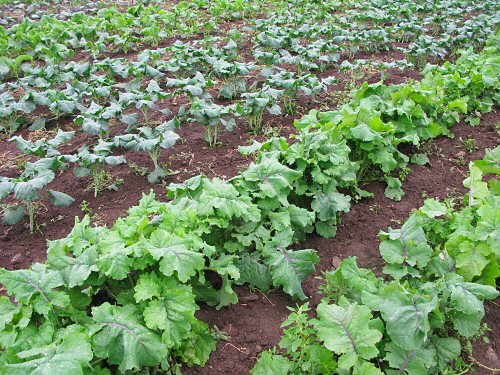 Funded by: the Vegetable Industry and the Commonwealth Government through Horticulture Australia Limited (HAL)
Funded by: the Vegetable Industry and the Commonwealth Government through Horticulture Australia Limited (HAL)
Projects VG05005, VG06018 and VG190129
Contacts: Lynette Deland or Barbara Hall
The SARDI Horticulture Pathology Laboratory in Adelaide is investigating the disease complex devastating Brassicas in the Northern Adelaide Plains. The initial scoping study identified several fungal pathogens, including Leptosphaeria (Black leg), Rhizoctonia, Fusarium and Pythium. The disease is worst late winter into spring on cauliflower cultivars. Leptosphaeria maculans and Rhizoctonia solani (AG2.1, 2.2 and 4) are the main pathogens causing the disease, and studies in the greenhouse and field have been undertaken to develop effective management strategies. The final reports from VG05005 and VG06018 are available though HAL.
Outcomes of VG05005: Scoping study to determine the soilborne diseases affecting brassica crops
• Brassica stem canker is a disease complex of several fungi causing symptoms that range from superficial scurfing, russetting and discrete lesions on stems to complete stem rot and plant collapse. Fungal pathogens involved in the disease complex included Phoma (Black leg), Rhizoctonia, Fusarium and Pythium.
• Surveys conducted on 113 brassica crops throughout Australia showed stem canker occurred in all mainland states. While worst in cauliflower it was also detected on Brussels sprout, broccoli, green and red cabbage. In some plantings in South Australia, 100% of stems were affected and complete plant collapse occurred by harvest in the spring of 2005.
• The survey of 38 winter cauliflower plantings in South Australia showed that an estimated $309,000 per week was lost due to unmarketable and collapsed plants.
Outcomes of VG06018: Managing Brassica stem canker
No single treatment will control stem canker. However there are several management strategies that will suppress the disease, including:
• Pre plant seedling drenches of 40 ml/100L Maxim® or 100 ml/100L Amistar®.
• Planting less susceptible cultivar such as Skywalker.
• Avoiding overwatering.
• Controlling weeds such as stinging nettle, fat hen, wireweed, common purslane and paddymelon that host Rhizoctonia.
• Incorporating of plant residue after harvest and leaving for at least 12 months to reduce inoculum load.
Aim of VG09129: Brassica Stem canker: Phase 2
To evaluate commercially available fertilizers and biological agents that claim to have disease suppressive effects in greenhouse trials and on commercial properties. They will be evaluated both alone and in combination with fungicides, to determine if the suppressive effect can be enhanced to provide effective integrated control of Brassica stem canker.
Original Article Here







